Cascade CFD Simulation Training by Ansys Fluent
$80.00 $40.00 Student Discount
In this project, a cascade with an interrupted water inlet has been simulated and the results of this simulation have been investigated.
Click on Add To Cart and obtain the Geometry file, Mesh file, and a Comprehensive ANSYS Fluent Training Video.To Order Your Project or benefit from a CFD consultation, contact our experts via email (info@mr-cfd.com), online support tab, or WhatsApp at +44 7443 197273.
There are some Free Products to check our service quality.
If you want the training video in another language instead of English, ask it via info@mr-cfd.com after you buy the product.
Description
Cascade Project Description
The goal of this project is to simulate a cascade with an interrupted water inlet by ANSYS Fluent software. The Eulerian multiphase model has been used. The water is entering the domain with a speed of 0.3 m/s with gravity considered as -9.81 m/s-2 on the y-axis.
Geometry & Mesh
The 2-D geometry of the present model is carried out using Design Modeler software. The geometry consists two-section, the lower section is resident water, and the upper section contains outlet and velocity inlet; tank sides are considered as well.
c
The meshing of this present model has been generated by Ansys Meshing software. The mesh grid is unstructured with no element quality lower than 0.53, and the total cell number is 110976.
Cascade CFD Simulation
To simulate the present model, several assumptions are considered, which are:
- The solver is pressure-based and transient.
- Simulation has only examined fluid behavior; in other words, heat transfer simulation has not been performed.
- The effect of gravity on the flow is considered to be 9.81 m.s-2 and along with the y-axis in the present model.
The following is a summary of the steps for defining the problem and its solution
| Models | ||
| K-omega | Viscous model | |
| SST | k-omega model | |
| shear flow corrections | k-omega options | |
| air | primary phase | |
| water | secondary phase | |
| explicit | formulation | |
| Boundary conditions | ||
| Velocity-inlet | Inlet | |
| 0 | initial gauge pressure | Mixture |
| 0.3 m/s | velocity magnitude | Water |
| 1 | volume fraction | |
| Pressure outlet | outlet | |
| 1 | backflow volume fraction | Air |
| 0 | backflow volume fraction | Water |
| wall | Wall | |
| stationary wall | wall motion | |
| Solution Methods | ||
| Phase coupled | pressure-velocity coupling | |
| PRESTO! | pressure | |
| first-order upwind | momentum | |
| first-order upwind | specific dissipation rate | |
| first-order upwind | volume fraction | |
| Initialization | ||
| standard | initialization method | |
| 0.3 m/s | water velocity (0,y,0) | |
| 0 m/s | air velocity (x,y,z) | |
| 1 | the secondary phase volume fraction | |
Cascade Results
At the end of the solution process, two-dimensional and three-dimensional velocity, air and water volume fraction, and animation are obtained. This 2-D simulation shows water starts to fall cascade for 0.75 seconds. Then velocity cuts off to 0 m/s for 0.75 and continues with 0.3 m/s for another 0.75 seconds. This process repeats over and over again.
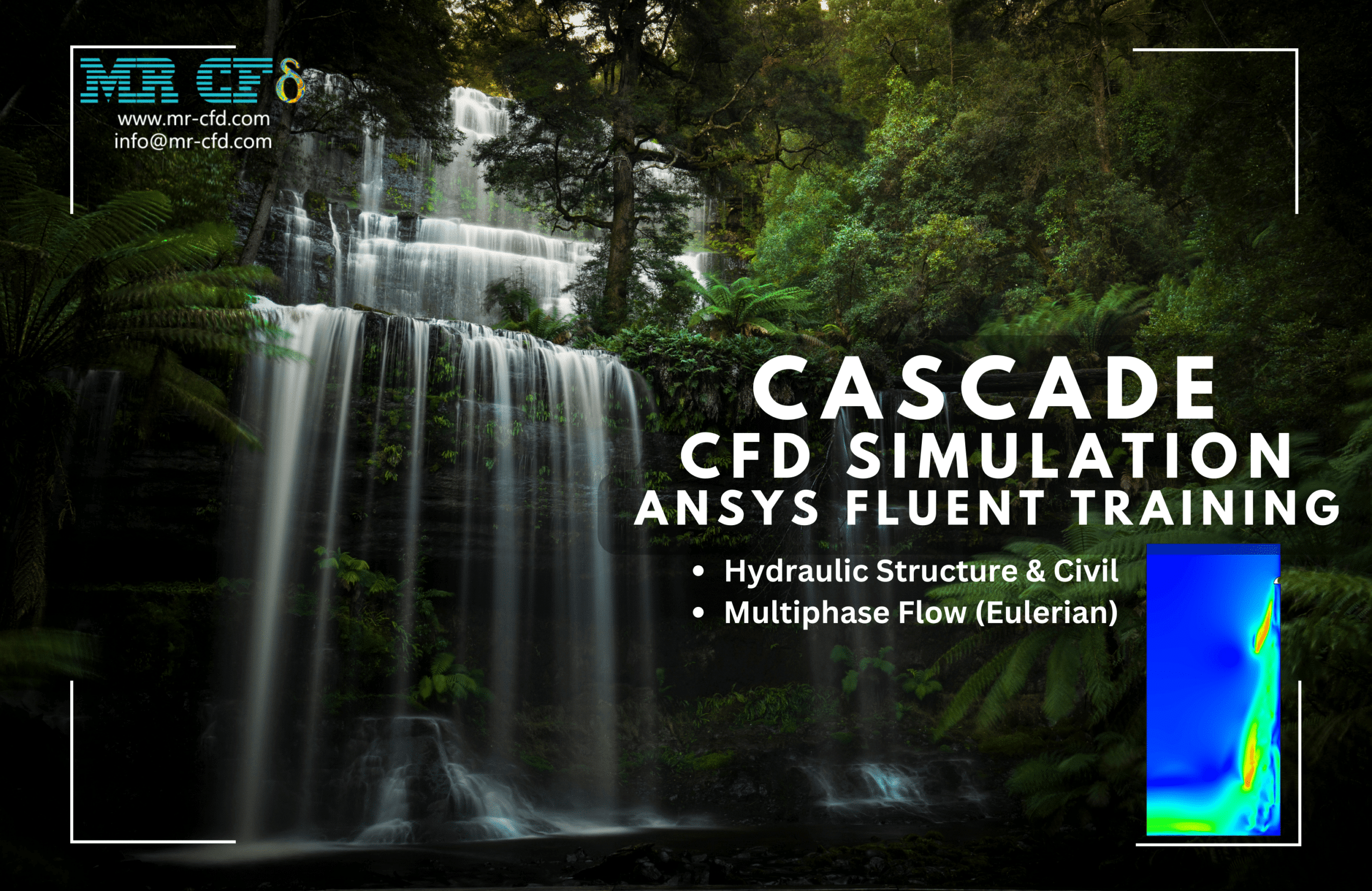
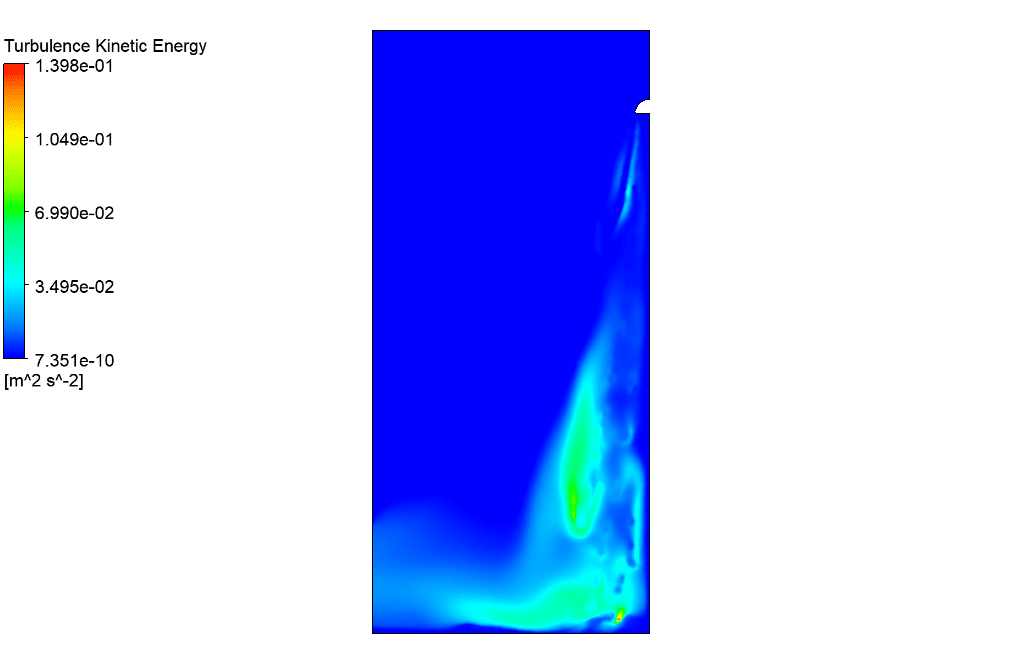
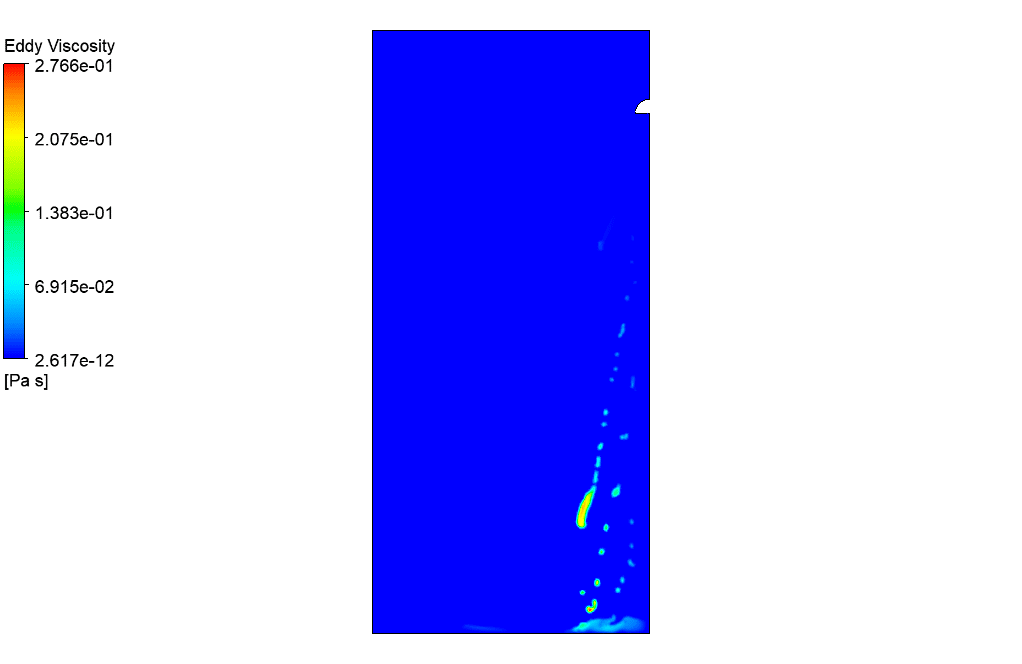
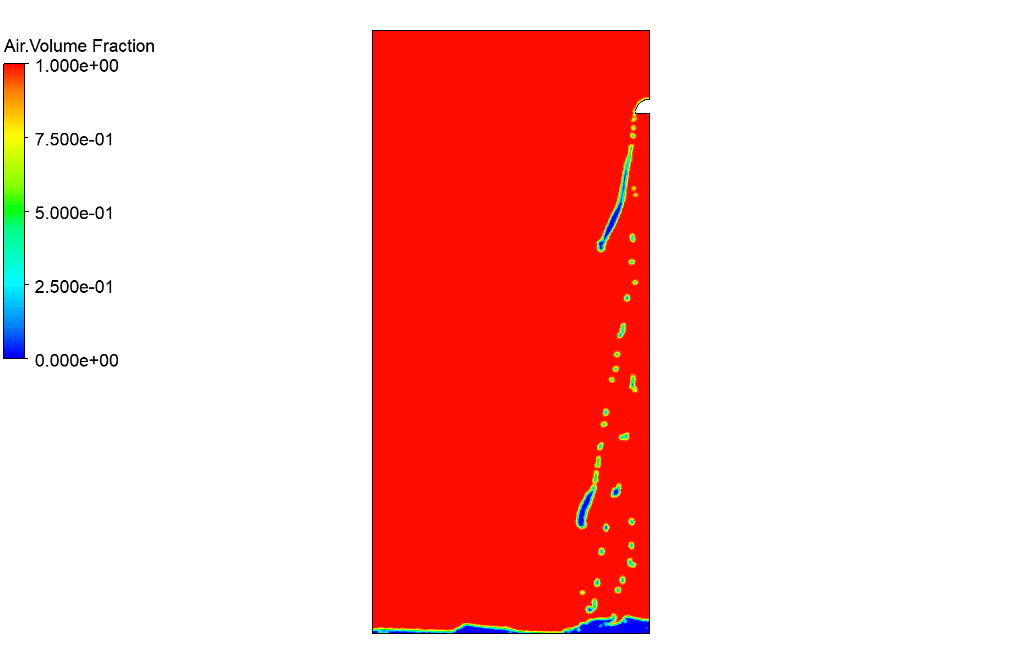
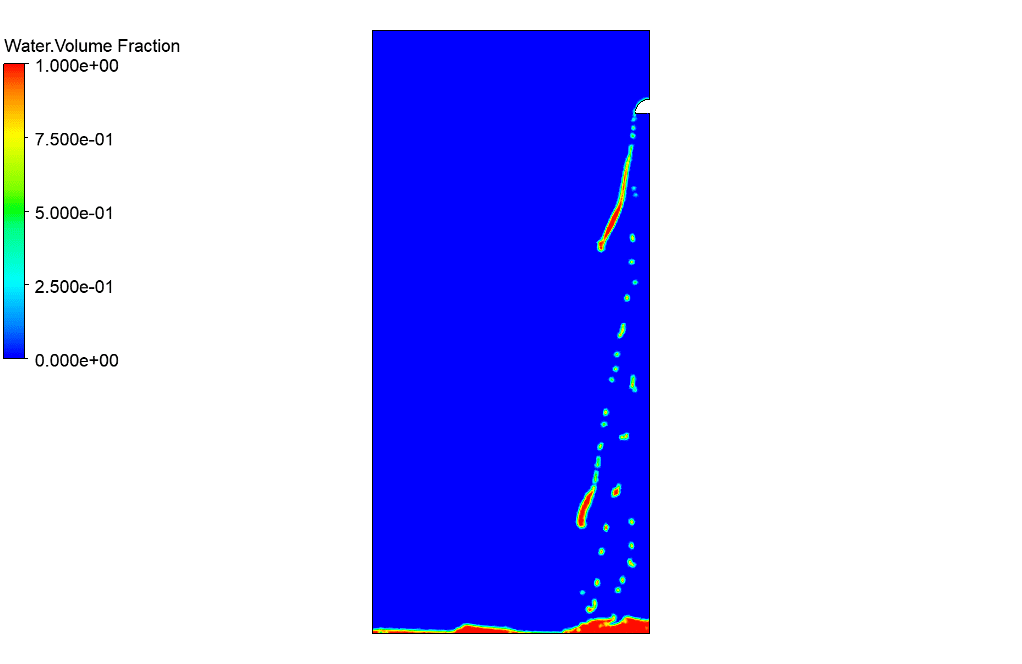
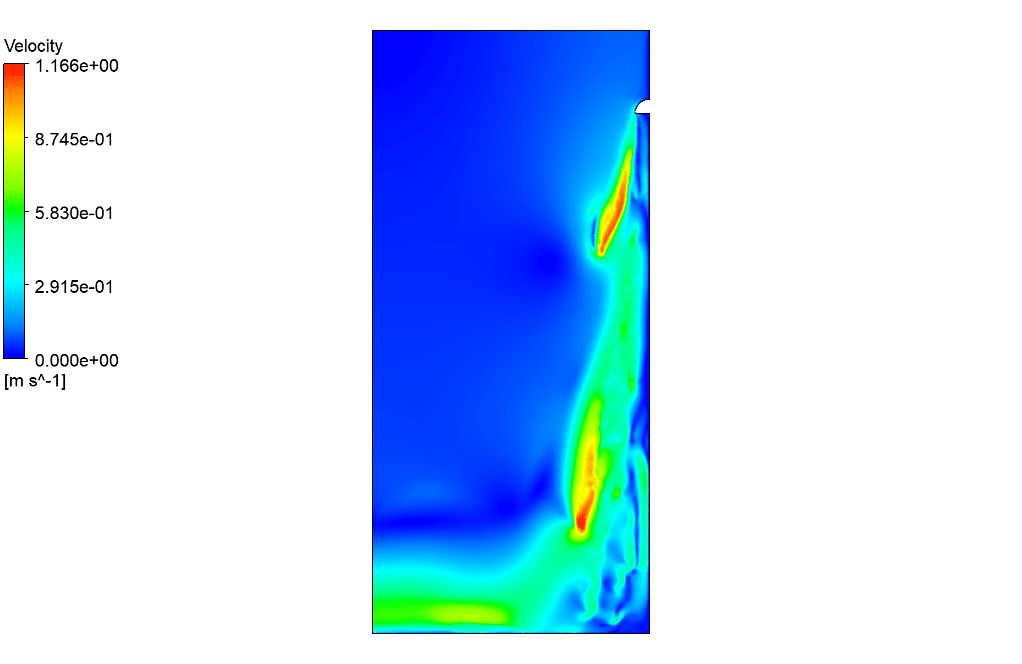


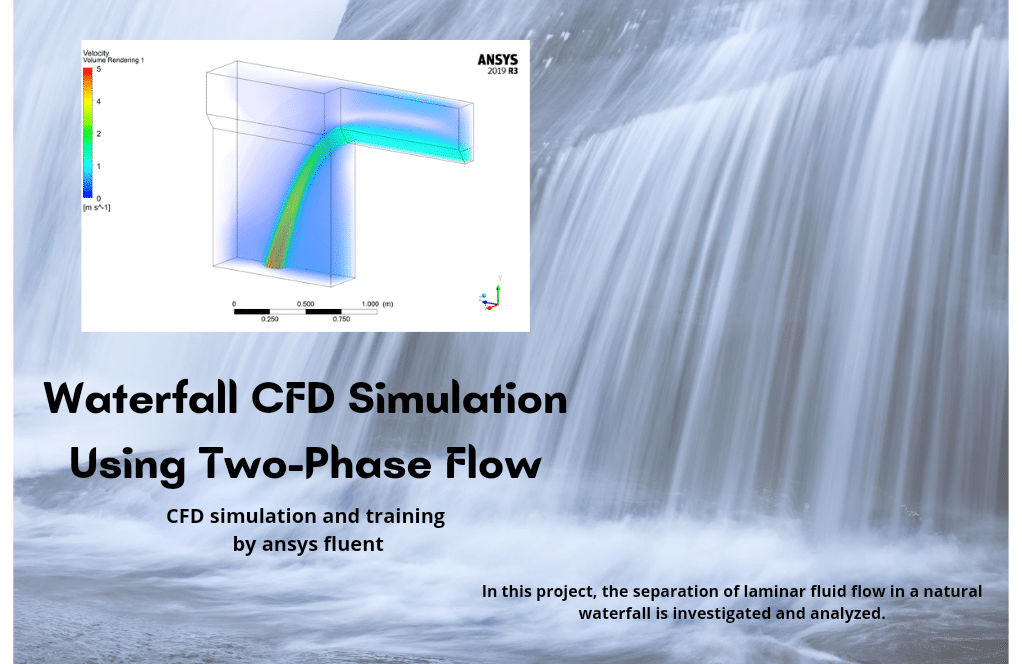



Dr. Jacky Ernser –
What happens when the velocity is cut off to 0 m/s?
MR CFD Support –
When the velocity is cut off to 0 m/s in the simulation, the water inflow is temporarily halted. This interruption in flow results in changes to the distribution of volume fractions of air and water within the cascade, as well as variations in the pressure and velocity fields until the inflow is resumed.
Louie Leannon V –
This product sounds really comprehensive! It covered everything that’s necessary for a multiphase flow simulation. The animation must give a great visualization of how the velocity changes during the simulation. Great job on detailing the cascade shedding process and implementing transient effects so well.
MR CFD Support –
Thank you very much for your positive feedback! We’re delighted to hear that you found the cascade CFD simulation training thorough and insightful. Visualizing the dynamic flow changes with an animation is crucial for understanding the simulation results, and we’re glad that this feature met your expectations. Should you have any further questions or need more training, don’t hesitate to reach out!
Marina Torphy –
I’ve applied the parameters outlined and followed all the steps, but I’m seeing deviations in my water velocity results. Why could that be happening?
MR CFD Support –
Deviations in your water velocity results compared to what’s expected from the simulation could be due to several factors. It could be resulting from differences in the meshing approach, precision of your boundary conditions setup, numerical diffusion due to discretization methods, or even solver settings. It’s crucial to ensure all numerical settings match what’s recommended and to confirm your mesh independence for an accurate analysis. Minor discrepancies are common, but significant deviations warrant a closer review of your simulation setup.
Margaret Friesen –
I’m really impressed with how this course is structured to deliver a comprehensive simulation learning experience. The integration of multiphase models and handling of dynamic boundary conditions demonstrates a high level of complexity managed effectively.
MR CFD Support –
Thank you for your positive feedback! We’re glad to hear that you appreciate the course’s structure and content. Our objective is always to create detailed educational experiences that cover complex simulation scenarios, and it’s reassuring to know that we’re achieving that. If you have any further questions or need more assistance in your learning journey, feel free to reach out.
Sigurd Toy –
I’m thrilled with the complexity and detail offered in the cascade CFD Simulation Training. It certainly adds depth to my understanding of multiphase flows.
MR CFD Support –
Thank you for sharing your positive experience. We’re delighted to know the training exceeded your expectations and helped in advancing your knowledge of multiphase flows using ANSYS Fluent. If you need any further assistance or information regarding our products, feel free to reach out to us.
Wallace Klocko II –
The training seems very thorough. The inclusion of unsteady flow modeling and the ability to simulate changes in water inlet velocity are excellent for understanding real-world cascade scenarios. Well done to the MR CFD team!
MR CFD Support –
Thank you for your positive feedback! We are delighted to know that you find the cascade CFD simulation training useful and that it matches real-world scenarios. We aim to provide comprehensive educational materials, and your opinion confirms that we are on the right track. Thanks again for choosing our product.
Dr. Rickie Greenholt –
The review and explanation of the cascade simulation project was quite thorough. Exceptional learning material for understanding the multi-phase dynamics in such a scenario. The visualization of air-water interactions besides the sudden interruptions in water velocity helped grasp the phenomenon!
MR CFD Support –
Thank you for your positive feedback on our Cascade CFD Simulation training material. We’re delighted to hear that you found the multi-phase dynamics explanation and visualization helpful for understanding the air-water interactions. If you have any further questions or need additional guidance, please feel free to reach out.
Dr. Reinhold Purdy III –
I’m truly fascinated by how easily the cascade model handles variable velocity inlets in ANSYS Fluent! Outstanding work on showing the transient behaviors.
MR CFD Support –
Thank you so much for your kind words! We’re thrilled to hear that you find the transient behavior of our cascade simulation impressed and understandable. It’s our goal to provide clear insights and understanding through our simulations. Your positive feedback is greatly appreciated!
Miss Agustina Schaefer –
The simulation sounds interesting. Can you please explain how the interruption of the water inlet is modeled within the ANSYS Fluent?
MR CFD Support –
In this simulation, the interrupted water inlet is modeled using a time-dependent expression for the inlet velocity. The velocity inlet boundary condition is set up to vary the water’s velocity, flowing into the simulation domain according to predefined time intervals. Specifically, for this simulation, the inlet velocity is set to 0.3 m/s for certain periods, then cut off to 0 m/s and repeated cyclically to mimic the interruption as per the project description. The timing and intervals are likely managed through the use of User-Defined Functions (UDFs) or a transient simulation with time-step adjustments.
Felipe Padberg Sr. –
I’m impressed with the comprehensive analysis of the cascade simulation training, but could you provide more details on how the intermittent water inlet impacts the fluid flow in the system over time?
MR CFD Support –
In the simulation, the intermittent water inlet is designed to replicate the periodic introduction of water at a specific velocity. This causes fluctuations in water levels and velocity patterns within the domain. As a result, the fluid dynamics of the cascade are significantly affected, leading to varying water and air volume fractions as well as changes in velocities. The transient nature of the simulation captures these dynamic behaviors over time, enabling a detailed study on how such interruptions influence the overall flow and stability of the cascade.
Mr. Kurt Huels –
The training module on Cascade CFD Simulation by Ansys Fluent seems well-structured and comprehensive. The description shows a clear understanding of the simulation’s parameters and factors such as mesh quality and gravity influence. Bravo on the clarity and detailed explanation in the module, making complex concepts graspable.
MR CFD Support –
Thank you for your positive feedback regarding the Cascade CFD Simulation training with Ansys Fluent. We’re thrilled to learn the training material was clear and detailed, making it easier for you to understand complex simulation concepts. If you have any more questions or need further assistance, please don’t hesitate to reach out to us.
Eddie Roberts PhD –
I was fascinated by the dynamic inlet conditions used in the simulation. Can you explain how these varying inlet speeds impact the water flow and air entrainment within the simulation over time?
MR CFD Support –
Admin Response: In this cascade simulation where the water inlet speed varies over time, the dynamic inlet conditions significantly affect the flow patterns and the interaction between the water and air phases. When the inlet speed is high, we typically observe increased water momentum, leading to more pronounced turbulence and potential air entrainment as the water collides with the existing water body. Conversely, when the inlet speed is reduced to 0 m/s, the flow becomes calmer, allowing the turbulent structures to dissipate and reducing air entrainment. The repetitive on-and-off nature of the inlet generates a cyclical pattern of flow instabilities and calming periods, making it an excellent case for studying transient multiphase flow behavior.
Mr. Gilberto Hane –
Wow, this cascade simulation learning product seems quite comprehensive. I appreciate the clear breakdown of steps and the meshing quality consideration. The assumption list and summary points give good insight into the complexity and scope of the simulation!
MR CFD Support –
Thank you for taking the time to review our ‘Cascade CFD Simulation Training by Ansys Fluent.’ We’re glad you found the material to be comprehensive and educational. Your positive feedback is highly appreciated, and it means a lot to us. If there’s anything else you would like to learn or see, please let us know, and we’ll strive to meet your expectations!
Dallin Gaylord –
Fantastic training package. The clear description of boundary conditions and solution methods helped a lot. Seeing the effects of water velocity changes and gravity on the water-air interface in these simulations was particularly insightful.
MR CFD Support –
Thank you for your kind words! We are thrilled to hear that our training on Cascade CFD Simulation by Ansys Fluent provided you with clear insights and helpful information. Your appreciation greatly encourages us to keep offering educational and practical learning products.
Karley Stamm –
The interaction between the velocity cutoff and the water behavior was insightful. Your visualization made it easy to understand how intermittent water supply affects a cascade flow.
MR CFD Support –
Thank you for your kind words! We are delighted to hear that our simulation and visualization made the cascade flow dynamics clear. If you have any more questions or need further information, feel free to ask. We’re here to help!
Rae Yundt –
The tutorial sounds extensive, but I’m perplexed about how to set initial conditions for a multiphase flow. Could you elaborate on that, please?
MR CFD Support –
In this simulation, the initial conditions for the multiphase flow are set by defining a primary phase (air) and a secondary phase (water). To initiate the flow, you specify the water velocity (0.3 m/s specifically in the y-direction for this tutorial) and volume fraction (1 for water at the velocity-inlet boundary). For the air, since it is the primary phase, its velocity and volume fraction are both set to zero at the start. The initialization ensures that there is water at the inlet and air throughout the rest of the domain.
Kenny Zulauf –
I thoroughly enjoyed the Cascade CFD simulation training by Ansys Fluent. The step-by-step approach and the comprehensive explanations of multiphase modeling truly deepened my understanding of handling complex flow problems. Thank you for preparing such an insightful learning material.
MR CFD Support –
Thank you for your positive feedback. We’re thrilled that the training material has been helpful and has enhanced your understanding of multiphase fluid flow simulation. If you ever have any further questions or need more guidance, feel free to reach out to us!
Derrick Gleichner –
I found the change in water flow to be an interesting part of the simulation. Can you explain why the velocity cuts to 0 m/s periodically?
MR CFD Support –
The velocity periodically cuts to 0 m/s to simulate the water cascade with interrupted water inlet. This is done to mimic conditions where the water flow might stop due to external factors or to study the behavior of the cascade under pulsating flow conditions. It helps to analyze variables such as water resistance, pressure distribution, and the impact of external forces on the cascade flow dynamics.
Prof. Misael Hane II –
Awesome detail in the project notes! Really helped me understand the dynamics of the cascade simulation. Good job on maintaining sufficient mesh quality throughout.
MR CFD Support –
Thank you for your positive feedback! We’re delighted to know the project details were clear and helpful to enhance your understanding of the cascade simulation dynamics. We always strive for quality in both simulation detail and mesh metrics. Thank you for choosing MR CFD for your learning experience, we’re here to support you in your future simulation endeavors!
Miss Sallie Monahan PhD –
I was left in awe by how detailed the cascade simulation project is. Witnessing the fluid dynamics in action, especially the precision with which the cascade flow was depicted, truly enhanced my understanding of the concepts. Couple that with the structured approach towards boundary conditions and the solver setup, this training has undeniably bridged the gap between theory and practical application for me.
MR CFD Support –
Thank you for your kind words. We’re thrilled to know that our Cascade CFD Simulation Training has provided you with both a detailed understanding and a practical approach to learning fluid dynamics. If you have any more queries or need further assistance, don’t hesitate to reach out to us. It is always our pleasure to help learners connect theory with real-world applications.
Tracy Gutmann –
Can the unstructured mesh used in this simulation handle complex geometries effectively compared to structured meshing?
MR CFD Support –
The unstructured mesh is very efficient for handling complex geometries due to its flexibility in fitting into irregular shapes. Therefore, it is often preferred in scenarios where the geometry involves multiple curves and angles, as it can closely approximate the boundary shapes which helps in capturing dynamic behaviors accurately in the simulation.
Prof. Joaquin Ferry –
I’m impressed by the cascade CFD simulation and how well it demonstrated the fluid movements. Really sounds like a thorough analysis.
MR CFD Support –
Thank you for your kind words! We’re glad to hear that you were impressed with the cascade CFD simulation. Our team works hard to ensure a thorough and accurate analysis, and it’s rewarding to see that reflected in your feedback. If you have any further questions or need additional information, don’t hesitate to reach out.
Candice Mann –
The project description mentions ‘Eulerian multiphase model’ has been used. Could you explain the choice of this particular model for this simulation?
MR CFD Support –
The Eulerian multiphase model is chosen for this simulation as it allows for the simulation of separate and intermingling fluid phases. In this case, the interaction of air and water in the cascade is comprehensively modeled with interactions such as drag taken into account. The model is practical for complex fluid-fluid interactions, especially where the phases are not clearly separated and need to be treated concurrently.
Beaulah Dooley –
I learned a ton from the Cascade CFD Simulation Training – it walked me through every step from setting up my geometry in Design Modeler to interpreting the post-process results. Being able to visualize the air and water volume fractions was really valuable. How can I ensure that I’m getting the most accurate results when making adjustments to boundary conditions for my own simulations?
MR CFD Support –
Thank you for your positive feedback! To ensure the most accurate results when adjusting boundary conditions in your own simulations, it’s essential to understand the physical phenomena you’re modelling and to validate your model against experimental or analytical results when possible. Whenever you change a boundary condition, monitor the simulation’s convergence and observe how dependent variables are affected. By doing so, you can fine-tune your boundary conditions to reflect the real-world conditions as close as possible.
Davin Franecki II –
I’m impressed with the detail in the Cascade CFD Simulation Training by Ansys Fluent. How are complex free-surface dynamics like splashing or air entrainment handled in this model? Do the results accurately predict such phenomena?
MR CFD Support –
In the Cascade CFD simulation, the Eulerian multiphase model handles the complex free-surface dynamics. This model can capture the interface between air and water allowing it to simulate phenomena like splashing and air entrainment. To accurately predict these phenomena, mesh resolution, and appropriate physical boundary conditions are critical. However, keep in mind that the precision of such predictions can depend on many factors including modeling assumptions and computational resources.
Dr. Grayson Trantow –
The explanation of the the process is intriguing! The visuals coupled with the CFD results must provide a compelling insight on the model behavior. Well done on covering the specifics of the cascade simulation.
MR CFD Support –
Thank you for your positive feedback on our Cascade CFD Simulation training! We’re pleased to hear that the detailed explanation and the CFD results provided valuable insights. If you have any further questions or need additional support, feel free to reach out to us. We’re here to help ensure you have the best learning experience possible!
Dr. Anabelle Boyle –
This is a fantastic resource for learning about cascade simulations in Fluent! The detail in the steps and the consideration of gravity effects give a lot of clarity. Great work!
MR CFD Support –
Thank you for your positive feedback! We’re thrilled to hear our training product met your expectations and provided clear insights into cascade simulations using Ansys Fluent. If there’s anything more we can do to assist your learning experience, let us know!
Tyshawn Graham I –
I was amazed at the detail provided in the water and air volume fraction results! Could you visually distinguish between water and air phases in the simulation?
MR CFD Support –
Thank you for your positive feedback! Yes, in the simulation results, the water and air phases can be visually distinguished due to different colors and patterns used in the velocity, air, and water volume fraction contours. This differentiation helps in understanding the interaction between the two phases within the computational domain.
Miss Jane Champlin –
The training product explained the simulation really well, but is there any further material on managing solver settings when dealing with multiple phases in complex models?
MR CFD Support –
Thank you for reaching out with your question. While the product aims to comprehensively cover the intricacies of setting up a multiphase simulation, for more complex models and specific solver settings, we highly recommend checking out our advanced training modules or contacting our support team for personalized guidance. Our experts can help you delve deeper into the solver intricacies for complex multiphase models.
Ludwig Little –
I’m fascinated by the cascade simulation training. Do you offer any advanced tutorials that cover thermal analysis if one wants to include heat transfer in the simulation as well?
MR CFD Support –
Thank you for your interest! While this specific training focuses on fluid behavior and does not include heat transfer analysis, we do have advanced tutorials that cover a wide range of CFD problems, including thermal analysis. Please check our catalog for tutorials on conjugate heat transfer and other simulations where the heat transfer is included, or reach out to our customer support for personalized recommendations based on your interests.
Mr. Henri Waelchi –
I’m impressed with the way the cascade simulation handles the interrupted water inlet and models the gravity. Can you explain more about how the transition from falling water to a stopped state and back to the flowing state is implemented in the actual simulation? Is it controlled by a programmable function or simply a scheduled condition?
MR CFD Support –
The alternating behavior between flowing water and a stopped state is implemented using a programmable function within the simulation setup. A user-defined function (UDF) or expression can be written that specifies the velocity inlet condition as a function of time—0.3 m/s during the flow period and 0 m/s during the stop period. This programmed inlet condition then cycles according to the desired time increment, which in this case, is every 0.75 seconds. In ANSYS Fluent, this function would be applied to the velocity boundary condition, allowing the simulation to switch between the two states in a controlled and repeating pattern.
Tyrique Parisian –
I found the section on CFD simulation extremely enjoyable! It presented complex processes in a very concrete way, helping me grasp the dynamics of a cascade with interrupted water inflow. Understanding the gravity’s role alongside velocity conditions was particularly intriguing.
MR CFD Support –
Thank you for your kind review! We’re delighted to hear that the simulation was informative and made complex concepts more accessible. Your feedback is greatly appreciated, and it motivates us to keep providing high-quality CFD learning materials.
Mrs. Tanya McKenzie Jr. –
The detailed approach of phase separation wielded in this project to simulate radiator effectiveness is exceptional. Is it feasible to solarize our current building CFD cases using the same or a modulated version of these computational techniques?
MR CFD Support –
Certainly, the computational methodologies used in this cascade simulation, such as the Eulerian multiphase model, can be adapted to simulate various CFD scenarios including solar applications. The specifics would, of course, depend on the individual requirements of your project, but the foundational techniques can be modified to suit a diverse array of CFD applications.
Caleb Keeling –
The project description was really informative. It detailed the simulation setup convincingly and provided a strong visual representation of the entire process. I particularly appreciated how every step, from the inception of meshing to the results, was meticulously explained, which provided a comprehensive understanding of the project dynamics in cascade CFD simulation.
MR CFD Support –
Thank you for your positive feedback! It’s great to hear that the project description provided a clear and thorough understanding of the cascade CFD simulation process. We’re always happy to provide detailed and informative content to our users. If you have any more questions or need further information, please don’t hesitate to ask. Thank you for choosing our learning materials!
Prof. Tad Doyle –
The training is comprehensive, but could you explain more about the method used for initialization and why that specific approach was chosen?
MR CFD Support –
The standard initialization method was chosen to provide a stable starting point for the Fluid Domain by estimating a reasonable guess for the flow fields. The initial velocities for water and air are set based on the expected inlet conditions to ensure convergence and stability as the simulation progresses through the transient states.
Jackson Rolfson –
Really detailed explanation of the Cascade CFD Simulation! It seems like a practical approach for understanding fluid dynamics. Great job MR CFD!
MR CFD Support –
Thank you for your kind words! We’re thrilled to hear that you found our Cascade CFD Simulation training insightful and useful for learning about fluid dynamics. If you have any further questions or need more information on our training products, don’t hesitate to ask!